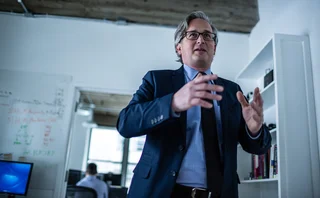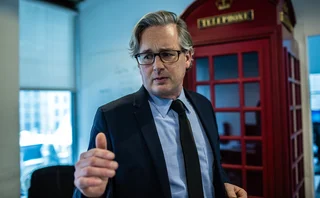The Hedge Fund Doctor: Charles Walters, Halcyon Capital Management
Charles Walters, chief information officer of Halcyon Capital Management, talks about his 20-plus years spent building and implementing platforms for hedge funds.

In the much-debated book Outliers, author Malcolm Gladwell wrote that what made The Beatles a great band were the years the quartet spent playing live shows in Hamburg. At the beginning of the 1960s, The Beatles played hundreds of shows in Germany, amassing 10,000 hours of real-world experience. By the time they played their first live show in the US on the Ed Sullivan Show at the beginning of 1964, they were a perfectly-oiled machine. And the crux of the book is that 10,000 hours of focused practice—doing, playing, programming, writing…whatever—is the “magic number to greatness.”
Charles Walters likes the 10,000-hour rule. From 1997 to 2014, he gained something of a PhD in hedge funds as a consultant.
Walters is like that Johnny Cash song—he’s been everywhere, man. Whether as a project manager or a senior consultant, he’s worked inside hundreds of buy-side shops—some that are still thriving, others that have vanished. Elliott Management, York Capital, Paulson & Co., Greenlight Capital, Icahn Associates, Pequot Capital, Allen & Company, Oaktree Capital, Fortress Investment Group—the list goes on and on.
“In the late 90s, I had an amazing opportunity to gain, essentially, a real-world PhD in hedge funds,” Walters says. “I learned different ways to solve a problem. I saw first-hand how different hedge funds were run and the different platforms they used.”

Another hedge fund on that list is Halcyon Capital Management. He first entered Halcyon as a senior consultant back in 2005. By that point, Walters was an expert on all things Advent Geneva—the ubiquitous portfolio management system—and most anything else produced by Advent Software (now SS&C Advent). If you had an implementation or decommission that needed oversight, Walters was a top name on that list to do it.
Nearly a decade passed from those first days at Halcyon, with Walters coming and going, aiding the fund with a variety of projects. Then, in 2014, the two stopped circling one another and made the relationship official, with Halcyon naming Walters as its chief information officer.
“I had been working at Halcyon as a vendor for a decade,” he recalls. “The executives and I used to kid that it was the longest job interview they ever had. There were times when some people would think I was a Halcyon employee and would ask why they hadn’t seen me around.”
For a man who had roamed New York and Connecticut like a hedge fund Rōnin, it was time to put some of what he learned to the test by running technology for a firm managing over $9 billion.
‘Halcyon SoHo’
While giving a tour of the tech department’s new digs, Sara Langbecker, director of application development, asks Walters with excitement: “Did you show him the door?” Sure enough, against one of the interior walls in the middle of the office that the tech department occupies, there’s a near floor-to-ceiling bookshelf adorned with a host of tchotchkes.
Pull on one of those decorations and the bookshelf pops open, revealing a door that leads to a hallway. There’s also the British-inspired red telephone booth. There’s the tile floor that looks like wood. There’s the exposed ceiling. And as you might expect, there are whiteboards plastered on almost every wall, replete with scribbled notes. It’s the IT version of a fancy SoHo loft.

The office, which was reopened in 2015, is split into four sections, and the segment that houses the majority of the technologists sits in the corner, featuring massive windows that provide a view of St. Patrick’s Cathedral and the scenery of Madison Avenue and 51st Street in Midtown Manhattan. Walters’ office has neither windows nor a computer. It has a phone and one day might feature an abacus, just to throw potential vendor clients off the scent of how tech-forward the place is. (His actual computer, which features multiple screens, is in a room in a shared space.)
One of the many things that Walters has learned in his travels is the importance of attracting and retaining talent. It’s the reason that under Walters’ stewardship, Halcyon has embraced experimenting with new tools, languages and products. It was also the thinking behind this space—that, and the fact that it makes for a nicer environment for Walters, himself, to come into on a daily basis.
“We’re a little bit different than the rest of the firm; we have a different purpose, but we’re also attracting and trying to retain different talent with a different outlook on life,” he says. “This space helps with that, and it’s also nice for me since I have to be here, too.”
The room definitely helps in giving off a fintech-startup feel. But it takes more than hidden doors, phone booths and outstanding views of Midtown to build platforms for a hedge fund that runs a diverse set of strategies—while stylish, the substance is there.
The Great Migration
Halcyon was founded in 1981. Today, with over $9 billion under management, it has offices in New York, London and Luxembourg, with over 110 employees. While it oversees an array of strategies—from multi-strat to equity to loans to 40 Act and Ucits offerings—it’s largely described as a credit fund. Halcyon has also been a leading firm in the realm of litigation finance, with the pension and endowment fund Hartford HealthCare recently committing $20 million to Halcyon.
The fund’s diversity was a major reason Walters decided to sign on as CIO. It’s generally said that there are two types of technologists: change agents and maintenance people. Both are necessary, but Walters is certainly the former.
Beyond the technology, he wants to understand fully how the business works. Halcyon has groups that are kind of like law firms that trade stocks. They have some business units that are more like equity-research firms that trade stocks. They have some business units that have specialties in certain investment products that are a blend of those two disciplines. As such, they need technologists that are also subject-matter experts.
“The player-coach model is very popular in the hedge-fund space,” he says. “What attracted me to Halcyon is I like getting my hands dirty and understanding things at a deep level and understanding the business proposition in a real way.”
In 2016, Halcyon replaced its portfolio accounting system. The previous platform had been in use for almost two decades—it was the hedge fund equivalent of Bank of America changing its core banking system. To help with the migration to the new solution—which was a blend of Eze Software and Black Mountain Systems—Walters sat on the trading desk for the first eight months to both support the models they were updating and to figure out how best to streamline workflow, front-to-back. It was important to demonstrate that he had a knowledge of the business and the pains they were experiencing.
It also helped that he’s gone through his fair share of migrations and understands that nothing goes 100-percent smoothly.
“I’ve worked with a lot of hedge funds and what I always tell people is that no one did everything perfectly,” Walters says. “It was always fascinating for me to see the different approaches people—and even different departments—would use to solve different problems. And I always say that these different hiccups are part of the process of bringing in a new platform, a new system.”

The Meandering Path
Born in Maryland, Walters was raised in Greensboro, North Carolina, and graduated from the University of North Carolina at Greensboro. After earning degrees in economics and history, in 1995 he took a job at Wachovia (which was gobbled-up by Wells Fargo after the financial crisis) where he was thrown into a project overseeing the migration of Wachovia’s proprietary trust system to a third-party solution.
Looking to explore the world beyond the Tar Heel State, in 1997 he took a job at Advent Software (which was gobbled-up by SS&C Technologies in July 2015). Three years there and a drive-by during the dot-com era at Banter Systems in 2001, he decided to help the Salvation Army with its IT response post-9/11 and oversaw the organizational rollout of a new accounting system.
After the Salvation Army and some time off to travel the world, he settled into the hedge fund consultant life at his own company, Charles Walters Technology, then at Ryan Associates from 2005 to 2012, and, finally, at his own spinoff, Jake Roy Pillar, which was eventually bought by Options IT. (As you can tell, the consultant’s life is fluid.) From there, Halcyon’s siren song called.
But those days spent as a consultant could best be described as his “Hamburg Years”. After becoming a specialist in Advent Geneva implementations, he eventually expanded his repertoire to include Eze Castle Software—which would eventually turn into Eze Software Group—and dealt in RealTick and Tradar projects. And since these Advent and Eze platforms are so robust, if you’re expert in how to implement those systems, you also need to become an expert as to how those systems integrate with most every other third-party solution on the market.
That’s why working at such an assemblage of hedge funds has proven beneficial to Walters: He’s seen the best and the worst of integrations; he’s experienced almost every kind of outage; he’s been introduced to a cacophony of ways to deliver data across an organization, from the front office to the back and out to every kind of hedge fund business unit one could even image.
For Walters, the Tao of a successful technology department is this: You need different approaches—different ideas—to solve the problems that spring up on a near-daily basis inside a buy-side shop. The most successful hedge funds he’s seen embrace outside input. But often, as a consultant, egos can get in the way. A trader fresh off his Harvard-to-Goldman-Sachs-to-hedge-fund tract is going to be less inclined to hear a vendor out, even if that vendor has worked inside some of the most notable funds in Midtown and Greenwich. They don’t yet see that experience begets wisdom.
“After you’ve been at a few places, you start to understand that it takes a lot of different inputs—a lot of different perspectives—and things change over time. It’s that willingness and understanding to take in different perspectives and views that served me well, served my clients well, and is now serving Halcyon well,” he says.
It’s a perfect match for Walters, too, as Halcyon is always on the lookout for new investment opportunities, which allows the technologists to explore new techniques for structuring and crunching data, trying out new visualization tools, and dabbling in solutions that employ artificial intelligence (AI).
“What attracted me to Halcyon was how entrepreneurial they have been over the years,” he says. “They’ve added different lines of businesses. They’ve been unafraid to venture into areas that other firms may be hesitant to, as long as it’s in their wheelhouse and makes sense to them. They’re investing hedge-fund-type assets in more of a private-equity-type structure.”

Targeted Solutions
If you spend enough time in the consultant world, you learn that everything is either coming or going. One day, you’re helping a firm with a new portfolio accounting system; five years later, you’re helping them migrate to a different system—again, a consultant’s life is fluid.
Walters isn’t looking for a one-size-fits-all model when it comes to technology. Halcyon’s structure, with its different businesses, is better served with more targeted solutions. Walters presented a vision for the company that was different from what had been implemented there previously. It moved away from that one-size-fits-all approach to one that looks similar to something like a mini-prime broker or fund administrator.
This structure has included the democratization of data so that technologists can support specific business functions to give them the information they most need; that means aligning technologists to specific units. Being that the firm has units that act as a law firm or as a private-equity firm, you have to deliver targeted applications to help users find the data they need, such as using e-discovery tools to find information more easily in email and text documents.
Under Walters, Halcyon is now also embracing open-source tools as it moves away from Microsoft and SharePoint projects. This has also meant a shift to HTML5 in order to make grids and views that were traditionally only available on desktops, also available on mobile devices. They even decided to make the move to HTML5 even before Microsoft announced it was sun-setting IE.
That move is helping to underpin the firm’s data visualization efforts, which have been rolled out in fits and starts, but the goal is to allow traders and investment professionals to find abnormalities or disturbances more easily and present that information in a graphical format that is easily processed and consumed. As such, they’ve also allowed for more programming languages to populate the firm, such as Python or C#, on a case-by-case basis.
Walters wants to remove some of the restraints that a one-size-fits-all approach brings about. He wants to take a more module-approach to technology solutions and figure out, for the various groups, what their needs are, as some business units will require perfectly polished and detailed reports that adhere to a specific format, while others are the polar opposite and just want more grids or access to the raw data.
“I’m generally agnostic, in many respects, to the technology; it’s about what’s going to benefit the business and fit into the overall IT strategy,” Walters says. “We’re lucky enough that we’re both small enough and big enough to be platform-agnostic and deliver to our users more high-touch solutions than firms that have [larger] mandates and not much flexibility.”
And to connect this all back to the space they built for the tech department, this helps in attracting talent. Just the same way that traders hate being handcuffed in what they can use, so too do top programmers and engineers. It will always be challenging to find and retain talent, so Walters needs to ensure that he can create an environment that is not only enjoyable to work in, but that will be mentally stimulating and allow these technologists to try new things.

The Seeker
Walters likes to have a lot of irons in a lot of fires—he’s a bit of a restless seeker.
In his final year of college, he was a real-estate appraiser and bought his first property at the age of 22, which he eventually flipped for a profit. Walters and a friend also created a placebo pill that can be sold at pharmacies—believe it or not, the Duane Reades in Manhattan don’t traditionally offer such a pill. (Why would you want a placebo? It can help with iritable bowl syndrome and other ailments, and it doesn’t require deception, studies have found.) He has also been experimenting with virtual and augmented reality (VR/AR). He even brought Google Glass onto the trading floor to see how price and data alerts could be consumed without changing one’s field of vision. While still early days, he thinks there’s a lot of potential there.
While Walters has amassed his 10,000 hours in the service of hedge funds, it doesn’t mean that he’s finished exploring other avenues of interest. And exploring is the key word. In addition to being a VR/AR enthusiast, he also likes toying around with drones.
One of Walters’ non-hedge fund ventures is pizza—specifically, he’s a co-owner of Williamsburg Pizza in Brooklyn. So, naturally, when you’re a technologist and own a pizza shop, why not try and create a new delivery mechanism? Everyone has their own claim to fame, but Walters’ is this: Williamsburg Pizza became the first company in New York City to successfully deliver a pizza via a drone.
Once again, Walters is a change-agent kind of technologist. “How many pizzerias have a chief technology officer?” he asks, with a wry smile.

Only users who have a paid subscription or are part of a corporate subscription are able to print or copy content.
To access these options, along with all other subscription benefits, please contact info@waterstechnology.com or view our subscription options here: https://subscriptions.waterstechnology.com/subscribe
You are currently unable to print this content. Please contact info@waterstechnology.com to find out more.
You are currently unable to copy this content. Please contact info@waterstechnology.com to find out more.
Copyright Infopro Digital Limited. All rights reserved.
As outlined in our terms and conditions, https://www.infopro-digital.com/terms-and-conditions/subscriptions/ (point 2.4), printing is limited to a single copy.
If you would like to purchase additional rights please email info@waterstechnology.com
Copyright Infopro Digital Limited. All rights reserved.
You may share this content using our article tools. As outlined in our terms and conditions, https://www.infopro-digital.com/terms-and-conditions/subscriptions/ (clause 2.4), an Authorised User may only make one copy of the materials for their own personal use. You must also comply with the restrictions in clause 2.5.
If you would like to purchase additional rights please email info@waterstechnology.com
More on Emerging Technologies
Editor’s Picks: Our best from 2025
Anthony Malakian picks out 10 stories from the past 12 months that set the stage for the new year.
The next phase of AI in capital markets: from generative to agentic
A look at some of the more interesting projects involving advanced forms of AI from the past year.
Market data costs defy cyclicality
Trading firms continue to grapple with escalating market data costs. Can innovative solutions and strategic approaches bring relief?
As trading firms embrace AI, so do hackers
According to a Google cybersecurity report, cybercriminals are turning to AI to sharpen their attacks.
AI & data enablement: A looming reality or pipe dream?
Waters Wrap: The promise of AI and agents is massive, and real-world success stories are trickling out. But Anthony notes that firms still need to be hyper-focused on getting the data foundation correct before adding layers.
Waters Wavelength Ep. 343: Broadridge’s Jason Birmingham
This week, Jason Birmingham of Broadridge talks with Tony about the importance of fundamentals as technology rapidly evolves.
Data standardization is the ‘trust accelerator’ for broader AI adoption
In this guest column, data product managers at Fitch Solutions explain AI’s impact on credit and investment risk management.
BNY inks AI deal with Google, Broadridge moves proxy voting to AWS, Expero delivers ICE market data, and more
The Waters Cooler: TSX Venture Exchange data hits the blockchain, SmartTrade acquires Kace, and garage doors link to cloud costs in this week’s news roundup.








